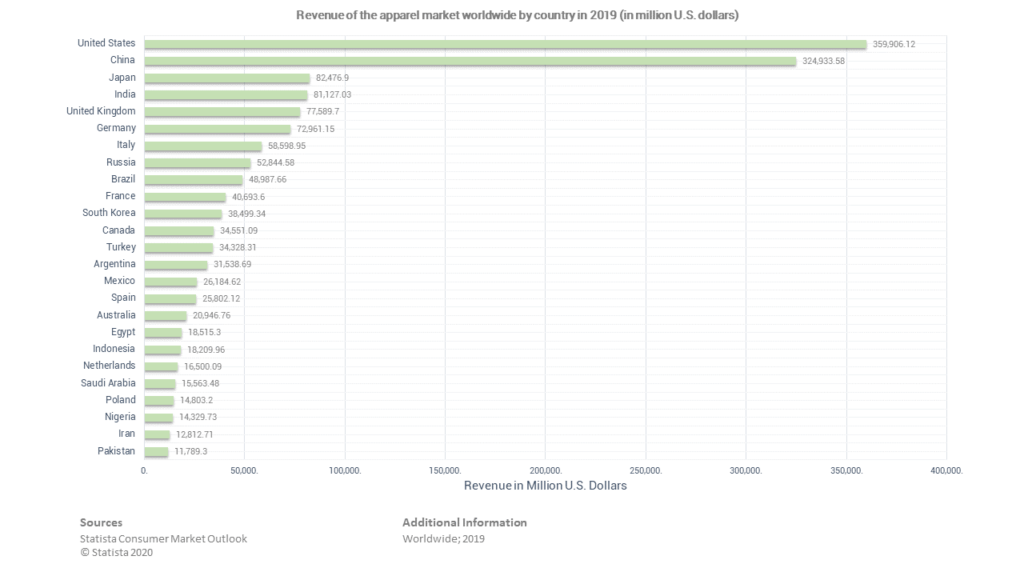In 2020, the global clothing market revenue reached around $527.1 billion after falling at a compound annual growth rate (CAGR) of -0.6% since 2015. The COVID-19 crisis was the main cause of this falling growth due to the lockdown and social distancing demand in several countries.
Since then, the global economy had been slowing down across countries due to the crisis and the measures to contain it. Nevertheless, the global clothing market revenue is expected to recover and grow at a CAGR of 9.8% and reach $842.7 billion in 2025, and $1,138.8 billion in 2030.
With the modern and digital of the global clothing market keeps advancing, many major companies are starting to invest in computer-controlled embroidery systems. This can increase the efficiency of money and labor.
Read ahead for the complete global clothing market revenue in 2020 article with the predictions for the future!
The COVID-19 Crisis
In 2020, supply chains were disrupted due to trade restrictions, and consumption declined caused of the COVID-19 crisis. Many countries applied lockdown and social distancing, requiring the citizens to stay at home. It’s causing a massive restraint on the global clothing market revenue growth.
National government measures to contain the contagion have resulted in a halt in manufacturing activities and a reduction in economic activity with countries entering a ‘lockdown’ state and the crisis is expected to continue to negatively impact businesses throughout 2020 to 2021.
Despite everything that happened, it is expected that the global OEM manufacturing clothing market will recover from the crisis across the forecast period. As is considered a blockbuster unrelated to the fundamental weaknesses in the global clothing market revenue or economy.
The Global Clothing Market Revenue
Accounting for 33% of the market in 2020, Asia Pacific was the largest region in the global clothing market, followed by Western Europe with 28% of the global clothing market revenue.

The top ten countries with the largest nominal GDP are the United States, China, Japan, Germany, the United Kingdom, India, France, Italy, Canada, and South Korea. The United States accounts for 24.67% of the total global clothing market revenue, while China has a 17.39% share, 5.97% for Japan, 4.54% for Germany, and the United Kingdom accounts for 3.26%.
China, the United States, the United Kingdom, Germany, and Japan, are the largest retail markets globally. In global trade, China and the United States play a hefty role. China is the largest global clothing exporter, and the United States is the second largest importer.
The global clothing market is expected to grow from $527.08 billion in 2020 to $635.17 billion in 2021 at a compound annual growth rate (CAGR) of 20.5%. This growth is due to many companies trying to rearrange their operations and recover from the COVID-19 crisis, which led to restrictive containment measures.
Even so, in 2025, the global clothing market revenue is estimated to reach $842.73 billion at a CAGR of 7%.
The Global Clothing Market Forecast
In the clothing and leather products market, the clothing market was the largest segment which accounted for 64.4% of the total market in 2020.
The top opportunity in the clothing market segmented by type will occur in the womenswear segment, which will generate $162.4 billion in annual global sales by 2025. The top opportunity in the clothing market segmented by fabric type will appear in the man-made fibers segment (like polyester), which will earn $231.4 billion in global annual sales by 2025.
The top opportunity in the clothing market segmented by distribution channel will occur in the offline sales segment, which will account for $158.5 billion of annual global sales by 2025. The size of the clothing market will gain the most in China with $54.0 billion.
The recovery in the global clothing market also owing to the increased demand for online shopping (especially online in China) which helps the market growth. Both small and big companies can sell their products on an even larger platform, which will drive the growth of the apparel manufacturing market.
The Future of the Clothing Market
Clothes manufacturing companies are investing in computer-controlled embroidery systems to increase efficiency and reduce operating costs. This is a computer-controlled system-equipped sewing-embroidery machine, specially designed for efficient embroidery.
These industrial and commercial equipment are capable of creating designs automatically on fabrics, from pre-programmed digital embroidery patterns. There are single-needle machines that require manual intervention for thread-changing activities, and multi-needle sewing-embroidery machines with multiple sewing heads, which require an input sequence for automatic color changes.
The machine can produce custom clothing fabric effects, chain stitch embroidery, sequins, appliqué, cutwork, and many others, automatically with the help of defined inputs in digital formats. This machine is capable of performing functions such as editing and loading designs, creating digital design files, and monitoring the entire embroidery process.
Some major clothing companies that provide computerized embroidery machines for efficient clothes manufacturing are Richpeace, ZojeDayu, Happy, Unix, and Damei.




